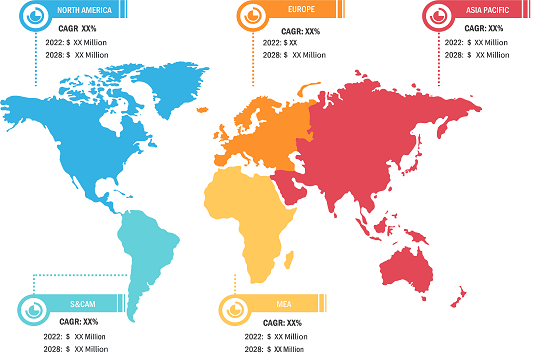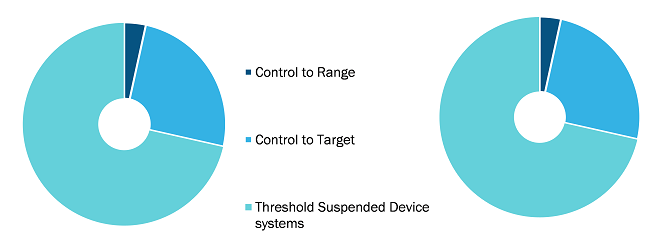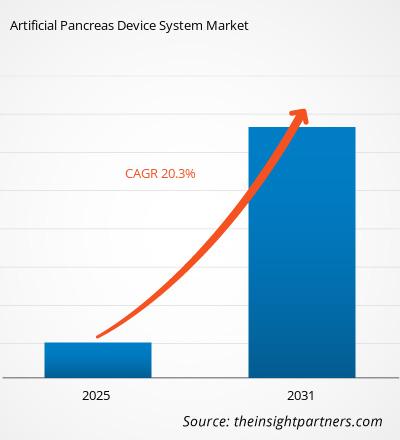Se prevé que el mercado de sistemas de dispositivos de páncreas artificial alcance los 3.585,75 millones de dólares estadounidenses para 2031 desde dólares estadounidenses. 1.190,23 millones en 2022; se estima que crecerá a una tasa compuesta anual del 20,28 % entre 2022 y 2031.
Los sistemas de dispositivos de páncreas artificiales copian fielmente la función reguladora de la glucosa del páncreas en forma. El dispositivo no solo monitorea los niveles de glucosa en el cuerpo sino que también ajusta automáticamente la distribución de la insulina para reducir los niveles de glucosa en sangre y reduce la incidencia de niveles bajos de glucosa en sangre con menos o ninguna intervención de los pacientes. Según la Administración de Alimentos y Medicamentos, el uso de un páncreas artificial se asocia con un mejor control de los niveles de azúcar en sangre en personas con diabetes tipo 1 en comparación con el tratamiento estándar.
El el mercado de sistemas de dispositivos de páncreas artificial está segmentado según el tipo y la geografía. Según la geografía, el mercado está ampliamente segmentado en América del Norte, Europa, Asia Pacífico, Medio Oriente y Asia. África y el Sur y el Sur. Centroamérica. El informe ofrece información y un análisis en profundidad del mercado, haciendo hincapié en parámetros como las tendencias del mercado, los avances tecnológicos y la dinámica del mercado, junto con el análisis del panorama competitivo de los principales actores del mercado a nivel mundial.
Perspectivas estratégicas
regiones lucrativas para el mercado de sistemas de dispositivos de páncreas artificial< /span>

Perspectivas del mercado
La creciente prevalencia de la diabetes refuerza el mercado de sistemas de dispositivos de páncreas artificial< /h3>
La diabetes es una enfermedad crónica potencialmente mortal que no tiene cura especializada. La enfermedad es causada principalmente por la incapacidad del cuerpo para producir o utilizar eficazmente la hormona insulina. Es una de las mayores emergencias sanitarias mundiales del siglo XXI. La diabetes impide que el cuerpo regule adecuadamente los niveles de glucosa en sangre. Hay dos tipos de diabetes, a saber, diabetes tipo I (también conocida como diabetes insípida) y diabetes tipo II (también denominada diabetes mellitus). La obesidad, el estilo de vida sedentario y los hábitos alimentarios poco saludables son los principales factores de riesgo asociados con el rápido aumento de la población diabética.
Según la Federación Internacional de Diabetes (FID), en América del Norte, se espera que el número de personas con diabetes aumente de ~46 millones en 2017 a ~62 millones en 2045; Es probable que la prevalencia de la enfermedad aumente aproximadamente un 35% durante el período previsto. Según la Asociación Americana de Diabetes, ~30,3 millones de personas, es decir, hasta el 9,4% de la población estadounidense, padecían diabetes; de ellos, 1,25 millones de niños padecían diabetes tipo I en 2017. Los Institutos Nacionales de Salud también afirman que la incidencia de diabetes tipo I está aumentando rápidamente en todo el mundo y afecta a un número significativo de niños y adolescentes. Según la misma fuente, ~84 millones de personas en el sudeste asiático padecen diabetes en 2017. De estos pacientes, 149.300 niños padecen diabetes tipo I y requieren una dosis diaria de inyecciones de insulina. La diabetes tipo 2 es la forma más prevalente de diabetes y ha aumentado junto con los cambios culturales y sociales. En los países de ingresos altos, hasta el 91% de los adultos diabéticos tienen diabetes tipo 2. Según la FID, aproximadamente 425 millones de personas en el mundo vivían con diabetes en 2017, y se espera que la cifra alcance los 629 millones en 2045.
La diabetes de todo tipo puede provocar diversas complicaciones en muchas partes del cuerpo y puede aumentar el riesgo general de muerte prematura. Las principales complicaciones asociadas con esta enfermedad son ataques cardíacos, accidentes cerebrovasculares, insuficiencia renal, amputación de piernas, pérdida de visión y daño a los nervios. Los pacientes que padecen diabetes requieren un seguimiento frecuente y la administración externa de insulina.
Type Insights
Según el tipo, el páncreas artificial El mercado de sistemas de dispositivos se segmenta en sistemas de dispositivos suspendidos de control a rango, control a objetivo y umbral. En 2022, el segmento de sistemas de dispositivos suspendidos por umbral tenía la mayor participación del mercado. Además, se espera que el segmento registre la CAGR más alta durante 2022-2031. Con los sistemas de dispositivo de suspensión de umbral, también llamados sistemas de suspensión de glucosa baja, la administración de insulina se suspende durante un tiempo determinado cuando 2 niveles de glucosa están por debajo de un nivel bajo específico, lo que indica hipoglucemia. Un dispositivo de umbral suspendido ayuda a revertir la caída de los niveles de glucosa en sangre. Con los sistemas de dispositivos de suspensión de umbral, también llamados sistemas de suspensión de glucosa baja, la administración de insulina se suspende durante un tiempo determinado cuando 2 niveles de glucosa están por debajo de un nivel bajo específico. Los dispositivos con umbral suspendido no pueden responder a un evento de nivel bajo de azúcar en sangre (hipoglucemia).
Mercado de sistemas de dispositivos de páncreas artificiales, por tipo: 2022 y 2031

Lanzamientos de productos y fusiones y adquisiciones son las estrategias más adoptadas por empresas que operan en el mercado mundial de sistemas de dispositivos de páncreas artificial. A continuación se enumeran algunos de los desarrollos de productos clave más recientes:
- En junio de 2021, Medtronic recibió la marca CE para el sistema MiniMed 780G para curar pacientes con diabetes tipo 1 del grupo de edad de 7 a 80 años. mayor de edad.
- En abril de 2022, Abbott colaboró con Ypsomed, CamDiab para llevar el sistema de páncreas artificial a Europa.
- En enero de 2021, Medtronic lanzó su sistema MiniMed 780G en el Reino Unido. Es un avanzado sistema híbrido de administración de insulina de circuito cerrado que se utiliza para el tratamiento de la diabetes tipo 1 en personas de 7 a 80 años.
Mercado del sistema de dispositivo de páncreas artificial: ndash; Segmentación del mercado
En términos de tipo, el páncreas artificial El mercado de sistemas de dispositivos se segmenta en sistemas de dispositivos de control a rango, control a objetivo y umbral suspendido. Según la geografía, el mercado se divide en América del Norte (EE. UU., Canadá, México), Europa (Francia, Alemania, Reino Unido, Italia, España y resto de Europa), Asia Pacífico (China, Japón, India, Australia, Corea del Sur). y resto de Asia Pacífico), Oriente Medio y Asia. África (Arabia Saudita, Sudáfrica, Emiratos Árabes Unidos y resto de Medio Oriente y África), América del Sur y Central (Brasil, Argentina y resto de América del Sur y Central)
Perfiles de empresas
- Defymed
- Typezero Technologies, Inc
- Insulet Corporation
- Bigfoot Biomedical, Inc
- Medtronic
- Dexcom, Inc
- Admetsys
- Beta Bionics
- Cellnovo
- Tandem Diabetes Care, Inc
- Análisis histórico (2 años), año base, pronóstico (7 años) con CAGR
- Análisis PEST y FODA
- Tamaño del mercado Valor/volumen: global, regional, nacional
- Industria y panorama competitivo
- Conjunto de datos de Excel

Report Coverage
Revenue forecast, Company Analysis, Industry landscape, Growth factors, and Trends

Segment Covered
This text is related
to segments covered.

Regional Scope
North America, Europe, Asia Pacific, Middle East & Africa, South & Central America

Country Scope
This text is related
to country scope.
Trends and growth analysis reports related to Life Sciences : READ MORE..
The List of Companies
- Defymed
- TypeZero Technologies, Inc.
- Insulet Corporation
- Bigfoot Biomedical, Inc.
- Medtronic
- Dexcom, Inc.
- Admetsys
- Beta Bionics
- Cellnovo
- Tandem Diabetes Care
The Insight Partners performs research in 4 major stages: Data Collection & Secondary Research, Primary Research, Data Analysis and Data Triangulation & Final Review.
- Data Collection and Secondary Research:
As a market research and consulting firm operating from a decade, we have published and advised several client across the globe. First step for any study will start with an assessment of currently available data and insights from existing reports. Further, historical and current market information is collected from Investor Presentations, Annual Reports, SEC Filings, etc., and other information related to company’s performance and market positioning are gathered from Paid Databases (Factiva, Hoovers, and Reuters) and various other publications available in public domain.
Several associations trade associates, technical forums, institutes, societies and organization are accessed to gain technical as well as market related insights through their publications such as research papers, blogs and press releases related to the studies are referred to get cues about the market. Further, white papers, journals, magazines, and other news articles published in last 3 years are scrutinized and analyzed to understand the current market trends.
- Primary Research:
The primarily interview analysis comprise of data obtained from industry participants interview and answers to survey questions gathered by in-house primary team.
For primary research, interviews are conducted with industry experts/CEOs/Marketing Managers/VPs/Subject Matter Experts from both demand and supply side to get a 360-degree view of the market. The primary team conducts several interviews based on the complexity of the markets to understand the various market trends and dynamics which makes research more credible and precise.
A typical research interview fulfils the following functions:
- Provides first-hand information on the market size, market trends, growth trends, competitive landscape, and outlook
- Validates and strengthens in-house secondary research findings
- Develops the analysis team’s expertise and market understanding
Primary research involves email interactions and telephone interviews for each market, category, segment, and sub-segment across geographies. The participants who typically take part in such a process include, but are not limited to:
- Industry participants: VPs, business development managers, market intelligence managers and national sales managers
- Outside experts: Valuation experts, research analysts and key opinion leaders specializing in the electronics and semiconductor industry.
Below is the breakup of our primary respondents by company, designation, and region:

Once we receive the confirmation from primary research sources or primary respondents, we finalize the base year market estimation and forecast the data as per the macroeconomic and microeconomic factors assessed during data collection.
- Data Analysis:
Once data is validated through both secondary as well as primary respondents, we finalize the market estimations by hypothesis formulation and factor analysis at regional and country level.
- Macro-Economic Factor Analysis:
We analyse macroeconomic indicators such the gross domestic product (GDP), increase in the demand for goods and services across industries, technological advancement, regional economic growth, governmental policies, the influence of COVID-19, PEST analysis, and other aspects. This analysis aids in setting benchmarks for various nations/regions and approximating market splits. Additionally, the general trend of the aforementioned components aid in determining the market's development possibilities.
- Country Level Data:
Various factors that are especially aligned to the country are taken into account to determine the market size for a certain area and country, including the presence of vendors, such as headquarters and offices, the country's GDP, demand patterns, and industry growth. To comprehend the market dynamics for the nation, a number of growth variables, inhibitors, application areas, and current market trends are researched. The aforementioned elements aid in determining the country's overall market's growth potential.
- Company Profile:
The “Table of Contents” is formulated by listing and analyzing more than 25 - 30 companies operating in the market ecosystem across geographies. However, we profile only 10 companies as a standard practice in our syndicate reports. These 10 companies comprise leading, emerging, and regional players. Nonetheless, our analysis is not restricted to the 10 listed companies, we also analyze other companies present in the market to develop a holistic view and understand the prevailing trends. The “Company Profiles” section in the report covers key facts, business description, products & services, financial information, SWOT analysis, and key developments. The financial information presented is extracted from the annual reports and official documents of the publicly listed companies. Upon collecting the information for the sections of respective companies, we verify them via various primary sources and then compile the data in respective company profiles. The company level information helps us in deriving the base number as well as in forecasting the market size.
- Developing Base Number:
Aggregation of sales statistics (2020-2022) and macro-economic factor, and other secondary and primary research insights are utilized to arrive at base number and related market shares for 2022. The data gaps are identified in this step and relevant market data is analyzed, collected from paid primary interviews or databases. On finalizing the base year market size, forecasts are developed on the basis of macro-economic, industry and market growth factors and company level analysis.
- Data Triangulation and Final Review:
The market findings and base year market size calculations are validated from supply as well as demand side. Demand side validations are based on macro-economic factor analysis and benchmarks for respective regions and countries. In case of supply side validations, revenues of major companies are estimated (in case not available) based on industry benchmark, approximate number of employees, product portfolio, and primary interviews revenues are gathered. Further revenue from target product/service segment is assessed to avoid overshooting of market statistics. In case of heavy deviations between supply and demand side values, all thes steps are repeated to achieve synchronization.
We follow an iterative model, wherein we share our research findings with Subject Matter Experts (SME’s) and Key Opinion Leaders (KOLs) until consensus view of the market is not formulated – this model negates any drastic deviation in the opinions of experts. Only validated and universally acceptable research findings are quoted in our reports.
We have important check points that we use to validate our research findings – which we call – data triangulation, where we validate the information, we generate from secondary sources with primary interviews and then we re-validate with our internal data bases and Subject matter experts. This comprehensive model enables us to deliver high quality, reliable data in shortest possible time.



 Obtenga una muestra gratuita de este informe
Obtenga una muestra gratuita de este informe